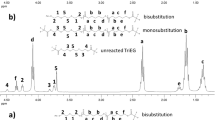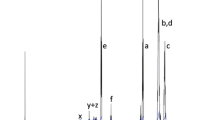Abstract
Terpenes with olefin methyl branches and bifunctional hydroxyl groups were used as initiators in the ring-opening polymerization of ε-caprolactone (CL) catalyzed by ammonium decamolybdate (NH4)6[Mo7O24], resulting in α-hydroxyl-ω-olefin poly(ε-caprolactone) (PCL) (Co–PCL–OH). The degree of polymerization was kept low (5 and 10) in all the species to increase the weight percent of the terminal group. Additionally, to compare the effects of the olefin terminal groups on PCLs, another family of PCL oligoesters with a linear alkyl terminal group α-hydroxyl-ω-alkyl PCL (Ca–PCL–OH) was synthesized under the same conditions. The olefin and alkyl terminal groups contained gradually increasing numbers of carbons (C5, C10, and C15). Both families of PCL oligoesters were characterized by different analytical techniques such as GPC, NMR, MALDI-TOF, and FT-IR spectroscopy to corroborate the chemical nature of the oligoesters and their end groups. Thermal properties were analyzed by scanning differential calorimetry (DSC), which showed significant differences between olefin and alkyl terminal groups; this affected PCL crystalline domains, as evidenced by the crystallization temperatures (Tc), melting temperatures (Tm), and crystallinities (xi) of the PCLs. In addition, computational studies using density functional theory indicated the differences in molar volume for the olefin and alkyl terminal groups.
Graphic abstract












Similar content being viewed by others
References
Arcana IM, Bundjali B, Hasan M, Ali Zulfikar M, Hariyawati K (2011) The effect of the soft segment of prepolymers on properties of poly(urethane-ester) and its biodegradability. Polym Int 60:1535–1540. https://doi.org/10.1002/pi.3114
Báez JE (2006a) Poli(ε-caprolactone), un polímero degradable: síntesis por triisopropóxido de aluminio Al(OiPr)3. Edu Quím 17:458–463. https://doi.org/10.22201/fq.18708404e.2006.4
Báez JE, Marcos-Fernández A, Lebrón-Aguilar R, Martínez-Richa A (2006b) A novel route to α, ω-telechelic poly(ε-caprolactone) diols, precursors of biodegradable polyurethanes, using catalysis by decamolybdate anion. Polymer 47:8420–8429. https://doi.org/10.1016/j.polymer.2006.10.023
Báez JE, Marcos-Fernández A, Galindo-Iranzo P (2011a) On the effect of alkyl end group in poly(ε-caprolactone) oligomers: preparation and characterization. Polym-Plast Tech Eng 50:839–850. https://doi.org/10.1080/03602559.2011.551976
Báez JE, Marcos-Fernández A, Galindo-Iranzo P (2011b) Exploring the effect of alkyl end group on poly(L-lactide) oligo-esters. Synthesis and characterization. J Polym Res 18:1137–1146. https://doi.org/10.1007/s10965-010-9517-y
Báez JE, Marcos-Fernández A, Martínez-Richa A, Galindo-Iranzo P (2017) Poly(ε-caprolactone) diols (HOPCLOH) and their poly(ester-urethanes) (PEUs): the effect of linear aliphatic diols [HO–(CH2)m–OH] as initiators. Polym-Plast Tech Eng 56:889–898. https://doi.org/10.1080/03602559.2016.1247273
Báez JE, Marcos-Fernández A, Navarro R (2019a) Similarities between homopolymers and triblock copolymers derived from poly(ε-caprolactone) (PCL) macrodiols (HOPCL–E–PCLOH and HOPCL–PEG–PCLOH) and their poly(ester-ether-urethanes): synthesis and characterization. Chem Pap 73:1287–1299. https://doi.org/10.1007/s11696-019-00683-3
Báez JE, Marcos-Fernández A, Navarro R, García C, Ramírez-Hernández A, Moreno KJ (2019b) A systematic study of macrodiols and poly(ester-urethanes) derived from α, ω-hydroxy telechelic poly(ε-caprolactone) (HOPCLOH) with different ether [CH2CH2O]m groups. Synthesis and characterization. J Polym Res 26:32. https://doi.org/10.1007/s10965-018-1682-4
Báez JE, Shea KJ, Dennison PR, Obregón-Herrera A, Bonilla-Cruz J (2020) Monodisperse oligo(δ-valerolactones) and oligo(ε-caprolactones) with docosyl (C22) end-groups. Polym Chem 11:4228–4236. https://doi.org/10.1039/D0PY00576B
Considine DM, Considine GD (1995) Terpenes and terpenoids. In: Van Nostrand's scientific encyclopedia, Springer, Boston, pp. 1–6.
Contreras JM, Medina D, López-Carrasquero F, Contreras RR (2013) Ring-opening polymerization of ε-caprolactone initiated by samarium acetate. J Polym Res 20:244. https://doi.org/10.1007/s10965-013-0244-z
Crescenzi V, Manzini G, Calzolari G, Borri C (1972) Thermodynamics of fusion of poly-β-propiolactone and poly-ϵ-caprolactone. comparative analysis of the melting of aliphatic polylactone and polyester chains. Eur Polym J 8:449–463. https://doi.org/10.1016/0014-3057(72)90109-7
Fahlbusch KG, Hammerschmidt FJ, Panten J, Pickenhagen W, Schatkowski D, Bauer K, Garbe D, Surburg H (2003) Flavors and fragrances. In: Ullmann's encyclopedia of industrial chemistry, Vol. 15, Wiley-VCH, Weinheim, pp. 73–198.
Frisch MJ, Trucks GW, Schlegel HB, Scuseria GE, Robb MA, Cheeseman JR, Scalmani G, Barone V, Petersson GA, Nakatsuji H, Li X, Caricato M, Marenich A, Bloino J, Janesko BG, Gomperts R, Mennucci B, Hratchian HP, Ortiz JV, Izmaylov AF, Sonnenberg JL, Williams-Young D, Ding F, Lipparini F, Egidi F, Goings J, Peng B, Petrone A, Henderson T, Ranasinghe D, Zakrzewski VG, Gao J, Rega N, Zheng G, Liang W, Hada M, Ehara M, Toyota K, Fukuda R, Hasegawa J, Ishida M, Nakajima T, Honda Y, Kitao O, Nakai H, Vreven T, Throssell K, Montgomery JA, Peralta JE, Ogliaro F, Bearpark M, Heyd JJ, Brothers E, Kudin KN, Staroverov VN, Keith T, Kobayashi R, Normand J, Raghavachari K, Rendell A, Burant JC, Iyengar SS, Tomasi J, Cossi M, Millam JM, Klene M, Adamo C, Cammi R, Ochterski JW, Martin RL, Morokuma K, Farkas O, Foresman JB, Fox DJ (2009) Gaussian 09 (Revision E.01), Gaussian Inc., Wallingford, CT
Gbolade AA, Lockwood GB (1990) Biotransformation of monoterpenes by polyurethane foam-immobilized cells of petroselinum crispum (Mill) Nyman. Zeitschrift Für Naturforschung C Biosci 45:245–248. https://doi.org/10.1515/znc-1990-3-417
Hanson JR (2009) Chemistry in the Garden. Royal Society of Chemistry (RSC), Cambridge
Jansen DJ, Shenvi RA (2014) Synthesis of medicinally relevant terpenes: reducing the cost and time of drug discovery. Fut Med Chem 6(10):1127–1148. https://doi.org/10.4155/fmc.14.71
John G, Nagarajan S, Vemula PK, Silverman JR, Pillai CKS (2019) Natural monomers: a mine for functional and sustainable materials-occurrence, chemical modification and polymerization. Prog Polym Sci 92:158–209. https://doi.org/10.1016/j.progpolymsci.2019.02.008
Kaplan Z, Böke H, Sofuoglub A, İpekoğlu B (2019) Long term stability of biodegradable polymers on building limestone. Prog Org Coat 131:378–388. https://doi.org/10.1016/j.porgcoat.2019.03.004
Khatiwala VK, Shekhar N, Aggarwal S, Mandal UK (2008) Biodegradation of poly(ε-caprolactone) (PCL) film by Alcaligenes faecalis. J Polym Environ 16:61–67. https://doi.org/10.1007/s10924-008-0104-9
Kowalski A, Duda A, Penczek S (2000) Mechanism of cyclic ester polymerization initiated with Tin(II) Octoate. 2. macromolecules fitted with Tin(II) alkoxide species observed directly in MALDI−TOF spectra. Macromolecules 33:689–695. https://doi.org/10.1021/ma9906940
Liu L, Wang GS, Yu T, Wang P (2013) Degradation of poly(e-caprolactone)/calcium sulfate whisker nanocomposites. Adv Mater Res 821–822:1043–1046
Lou X, Detrembleur C, Jérôme R (2002) Living cationic polymerization of δ-valerolactone and synthesis of high molecular weight homopolymer and asymmetric telechelic and block copolymer. Macromolecules 35:1190–1195. https://doi.org/10.1021/ma0113677
Mata-Mata JL, Gutiérrez JA, Paz-Sandoval MA, Madrigal AR, Martínez-Richa A (2006a) Ring-opening polymerization of ϵ-caprolactone initiated with different ruthenium derivatives: kinetics and mechanism studies. J Polym Sci Part A Polym Chem 44:6926–6942. https://doi.org/10.1002/pola.21787
Mata-Mata JL, Báez JE, Gutiérrez JA, Martínez-Richa A (2006b) Ring-opening polymerization of lactones using RuCl2(PPh3)3 as initiator: effect of hydroxylic transfer agents. J Appl Polym Sci 99:2737–2745. https://doi.org/10.1002/app.22963
Meereboer KW, Misra M, Mohanty K (2020) Review of recent advances in the biodegradability of polyhydroxyalkanoate (PHA) bioplastics and their composites. Green Chem 22:5519–5558. https://doi.org/10.1039/D0GC01647K
Miola-Delaite C, Hamaide T, Spitz R (1999) Anionic coordinated polymerization of ε-caprolactone with aluminium, zirconium and some rare earths alkoxides as initiators in the presence of alcohols. Macromol Chem Phys 200:1771–1778. https://doi.org/10.1002/(SICI)1521-3935(19990701)200:7%3c1771::AID-MACP1771%3e3.0.CO;2-V
Orozco-Castellanos LM, Marcos-Fernández A, Martínez-Richa A (2011) Hydrolytic degradation of poly(ε-caprolactone) with different end groups and poly(ε-caprolactone-co-γ-butyrolactone): characterization and kinetics of hydrocortisone delivery. Polym Adv Tech 22:430–436. https://doi.org/10.1002/pat.1531
Piskun YA, Vasilenko IV, Zaitsev KV, Oprunenko YF, Kostjuk SV (2017) Synthesis of functional poly(ε-caprolactone)s via living ring-opening polymerization of ε-caprolactone using functionalized aluminum alkoxides as initiators. Macromol Chem Phys 218(7):1600580. https://doi.org/10.1002/macp.201600580
Qian H, Bei J, Wang S (2000) Synthesis, characterization and degradation of ABA block copolymer of l-lactide and ε-caprolactone. Polym Degrad Stab 68:423–429. https://doi.org/10.1016/S0141-3910(00)00031-8
Rosa DDS, Calil MR, Guedes CDGF, Rodriges TC (2004) Biodegradability of thermally aged PHB, PHV-V, and PCL in soil compostage. J Polym Environ 12:239–245. https://doi.org/10.1007/s10924-004-8151-3
Saad GR, Lee YJ, Seliger H (2001) Synthesis and thermal properties of biodegradable poly(ester-urethane)s based on chemo-synthetic poly[(R, S)-3-hydroxybutyrate] macromol. Biosci 1:91–99. https://doi.org/10.1002/1616-5195(20010301)1:3%3c91::AID-MABI91%3e3.0.CO;2-8
Sivalingam G, Karthik R, Madras G (2003) Kinetics of thermal degradation of poly(ε-caprolactone). J Analyt Appl Pyrol 70:631–647. https://doi.org/10.1016/S0165-2370(03)00045-7
Stolt M, Krasowska K, Rutkowska M, Janik H, Rosling A, Södergård A (2005) More on the poly(L-lactide) prepared using ferrous acetate as catalyst. Polym Int 54:362–368. https://doi.org/10.1002/pi.1691
Tatai L, Moore TG, Adhikari R, Malherbe F, Jayasekara R, Griffiths I, Gunatillake PA (2007) Thermoplastic biodegradable polyurethanes: the effect of chain extender structure on properties and in-vitro degradation. Biomaterials 28:5407–5417. https://doi.org/10.1016/j.biomaterials.2007.08.035
Toncheva V, van den Bulcke A, Schacht E, Mergaert J, Swings J (1996) Synthesis and environmental degradation of polyesters based on poly(ε-caprolactone). J Environ Polym Degrad 4:71–83. https://doi.org/10.1007/BF02074868
van Genabeek B, Lamers BAG, Hawker CJ, Meijer EW, Gutekunst WR, Schmidt BVKJ (2021) Properties and applications of precision oligomer materials; where organic and polymer chemistry join forces. J Polym Sci 59:373–403. https://doi.org/10.1002/pol.20200862
Walinska K, Iwan A, Gorna K, Gogolewski S (2008) The use of long-chain plant polyprenols as a means to modify the biological properties of new biodegradable polyurethane scaffolds for tissue engineering. A pilot study. J Mater Sci Mater Med 19:129–135. https://doi.org/10.1007/s10856-007-3146-y
Wang M, Zhang Q, Wooley KL (2001) Silyl ether-coupled poly(ε-caprolactone)s with stepwise hydrolytic degradation profiles. Biomacromol 2:1206–1213. https://doi.org/10.1021/bm010093s
Wu C, Zhang Z, He F, Zhuo R (2013) Enzymatic synthesis of poly(ε-caprolactone) in monocationic and dicationic ionic liquids. Biotech Lett 35:879–885. https://doi.org/10.1007/s10529-013-1160-3
Wu J, Zhao L, Xu X, Bertrand N, Choi W II, Yameen B, Shi J, Shah V, Mulvale M, MacLean JL, Farokhzad OC (2015) Hydrophobic cysteine poly(disulfide)-based redox-hypersensitive nanoparticle platform for cancer theranostics. Angew Chem 127:9350–9355. https://doi.org/10.1002/ange.201503863
Yao L-H, Shao S-X, Jiang L, Tang N, Wu J-C (2014) Ring-opening polymerisation of ɛ-caprolactone catalysed by Brønsted acids. Chem Pap 68:1381–1389. https://doi.org/10.2478/s11696-014-0585-z
You X, Gu Z, Huang J, Kang Y, Chu C-C, Wu J (2018) Arginine-based poly(ester amide) nanoparticle platform: from structure-property relationship to nucleic acid delivery. Acta Biomater 74:180–191. https://doi.org/10.1016/j.actbio.2018.05.040
Zhang X, Wang Y, Zhang Z, Xia W, Song X, Ma L (2020) Modification of resveratrol via coupling six-armed PCL. Chem Pap 74:1377–1382. https://doi.org/10.1007/s11696-019-00973-w
Zhao Y, Schultz NE, Truhlar DG (2006) Design of density functionals by combining the method of constraint satisfaction with parametrization for thermochemistry, thermochemical kinetics, and noncovalent interactions. J Chem Theory Comput 2:364–382. https://doi.org/10.1021/ct0502763
Acknowledgements
José E. Báez would like to thank the Consejo Nacional de Ciencia y Tecnología (CONACYT) Ciencia Básica for the grant “Proyecto SEP/284893,” the Sistema Nacional de Investigadores (SNI), the Dirección de Apoyo a la Investigación y al Posgrado (DAIP), and the University of Guanajuato (UG) Mexico, for financial support. José E. Báez and María Guadalupe Ortiz-Aldaco kindly acknowledges the National Laboratory for Supercomputing Resources (UG-UAA-CONACYT: 123732). P. Denisse Falcón-Torres would thank DAIP for a scholarship. This work is dedicated to the memory of Mrs. Irene Caso Neira.
Author information
Authors and Affiliations
Corresponding author
Additional information
Publisher's Note
Springer Nature remains neutral with regard to jurisdictional claims in published maps and institutional affiliations.
Supplementary Information
Below is the link to the electronic supplementary material.
Rights and permissions
About this article
Cite this article
Falcón-Torres, .D., Morales-Segoviano, A. ., Martínez-Salazar, A. . et al. Terpenes versus linear alkyl substituents: effect of the terminal groups on the oligomers derived from poly(ε-caprolactone). Chem. Pap. 75, 5587–5598 (2021). https://doi.org/10.1007/s11696-021-01727-3
Received:
Accepted:
Published:
Issue Date:
DOI: https://doi.org/10.1007/s11696-021-01727-3




